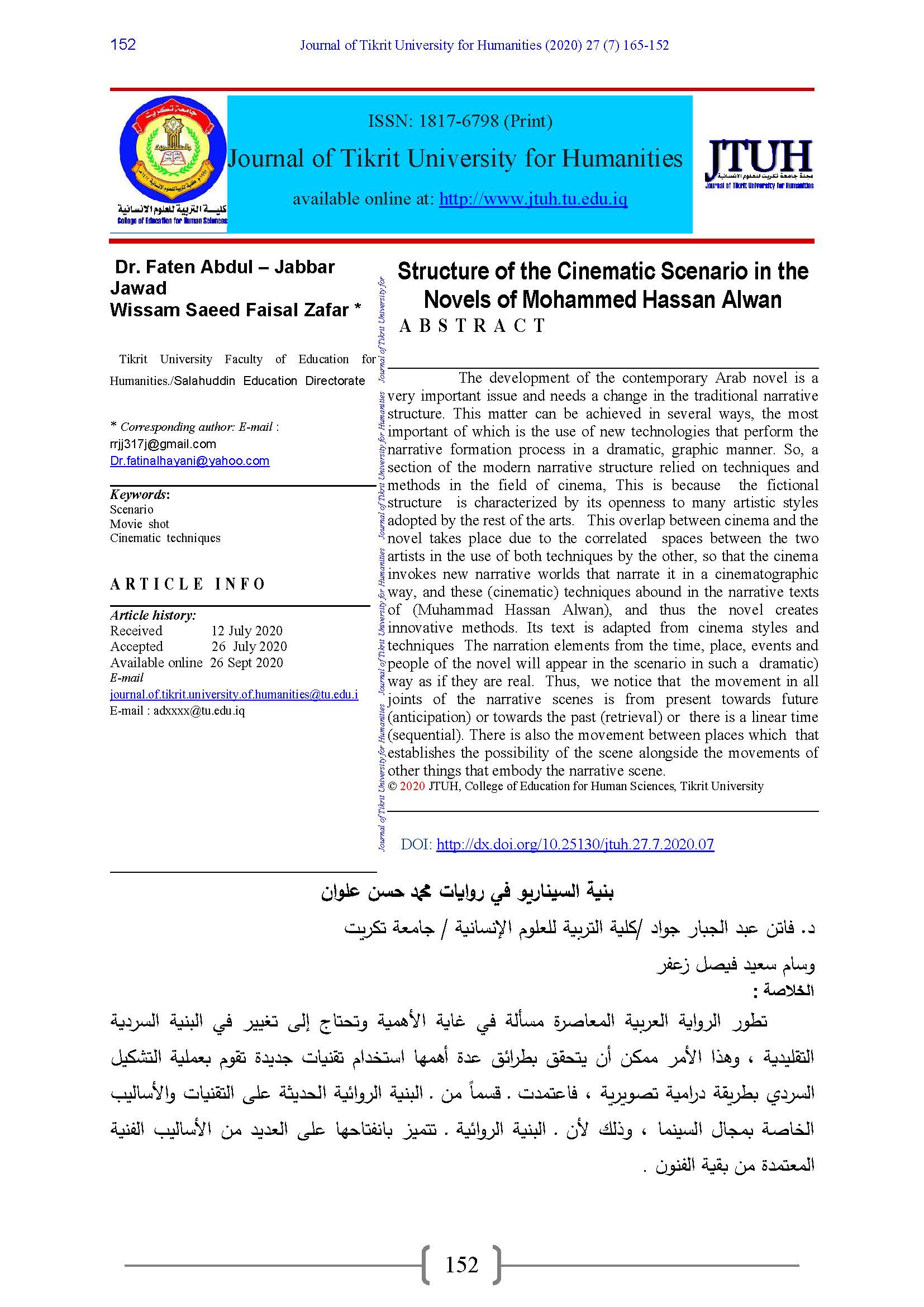Structure of the Cinematic Scenario in the Novels of Mohammed Hassan Alwan
Main Article Content
Abstract
The development of the contemporary Arab novel is a very important issue and needs a change in the traditional narrative structure. This matter can be achieved in several ways, the most important of which is the use of new technologies that perform the narrative formation process in a dramatic, graphic manner. So, a section of the modern narrative structure relied on techniques and methods in the field of cinema, This is because the fictional structure is characterized by its openness to many artistic styles adopted by the rest of the arts. This overlap between cinema and the novel takes place due to the correlated spaces between the two artists in the use of both techniques by the other, so that the cinema invokes new narrative worlds that narrate it in a cinematographic way, and these (cinematic) techniques abound in the narrative texts of (Muhammad Hassan Alwan), and thus the novel creates innovative methods. Its text is adapted from cinema styles and techniques The narration elements from the time, place, events and people of the novel will appear in the scenario in such a dramatic) way as if they are real. Thus, we notice that the movement in all joints of the narrative scenes is from present towards future (anticipation) or towards the past (retrieval) or there is a linear time (sequential). There is also the movement between places which that establishes the possibility of the scene alongside the movements of other things that embody the narrative scene.
Metrics
Article Details

This work is licensed under a Creative Commons Attribution 4.0 International License.
College of Education for Humanities, TIKRIT UNIVERSITY. THIS IS AN OPEN ACCESS ARTICLE UNDER THE CC BY LICENSE http://creativecommons.org/licenses/by/4.0/
References
First - narrative texts:
- Beaver, Muhammad Hassan Alwan, Dar Al-Saqi, 9th floor, 2018 A.D.
- The ceiling of sufficiency, Muhammad Hassan Alwan, Dar Al-Saqi, 16th floor, 2018 AD.
- Sofia, Mohammed Hassan Alwan, Dar Al-Saqi, 9th floor, 2017 AD.
- Touq al-Tahara, Muhammad Hassan Alwan, Dar al-Saqi, 6th Edition, 2018 AD.
- Small Death, Muhammad Hassan Alwan, Dar Al-Saqi, 4th floor, 2017 AD.
Second - References:
- Hadiths about cinematography, Michael Rom, translation: Adnan Madanat, Dar Al-Farabi, 1st edition, 1981 AD.
- The mechanisms of cinema in the novel “The Lamps of the King of Galilee” by Ibrahim Nasrallah, Khalil Brouini, and Shahram Dilshad, Journal of Critical Illuminations, Fifth Year - Seventeenth Issue, March 2015 AD.
- Interlacing literary genres, (Twelfth International Monetary Conference), (22-24 July 2008), Department of Arabic Language and Literature, Yarmouk University (Irbid - Jordan) - supervision and editing: a. Dr . Nabil Haddad, a. Dr . Mahmoud Darabseh, Modern Book World and Wall of International Book, 1 st, 1429 AH 2009 AD.
- Using the arts in “Ashes Al Sharq” by Wassini Al Aaraj, Sumaya Bidi, Journal of Literary and Intellectual Studies Generation - Fifth Year, Issue (45), October 2018 AD.
- Aesthetics (poetry, theater and cinema) in examples from the Arab story in Iraq, d. Hamad Mahmoud Al-Doukhi, General Cultural Affairs House (Ministry of Culture), Baghdad - 1st floor, 2018 AD.
- Film speech from image to image, Taher Abdul Muslim, General Cultural Affairs House, 1st floor, Baghdad, 2005 AD.
- The photo in narrative narration and cinematic narration, d. Fatima Badr, Al-Aqlam Magazine, second edition, 2010 AD.
- The art of screenwriting, Frank Harrow, translation: Rania Qirdahi, Publications of the Ministry of Culture, General Organization of Cinema, Damascus, seventh art (237), 2013AD.
- Writing a script for short films, Pat Cooper and Ken Insight, translation: Ahmed Youssef, the Egyptian General Book Authority - Cairo - (National Project for Translation) No. (1798), 1st edition, 2011 AD.
- How to write the script, Salah Abu Youssef, Dar Al-Jahez Publishing - Baghdad, The Little Encyclopedia (98) - August 1981 AD.
- The poetic montage in the contemporary Arabic poem (a study on the effect of vocabulary of the cinematic tongue in the poetic text), a. Dr.. Hamad Mahmoud Al-Dokhi, lines for publishing and distribution, 2nd edition, 2017 AD.
Third: Periodicals:
- Hiring arts in the novel "Ashes of the East" by Wassiny El Aaraj, Sumaya Bidi, Journal of Literary and Intellectual Studies Generation - Fifth Year, Issue (45), October 2018 AD.




